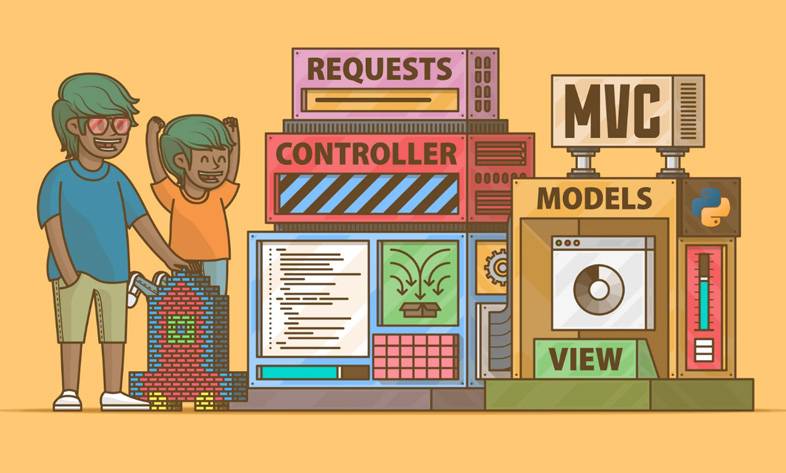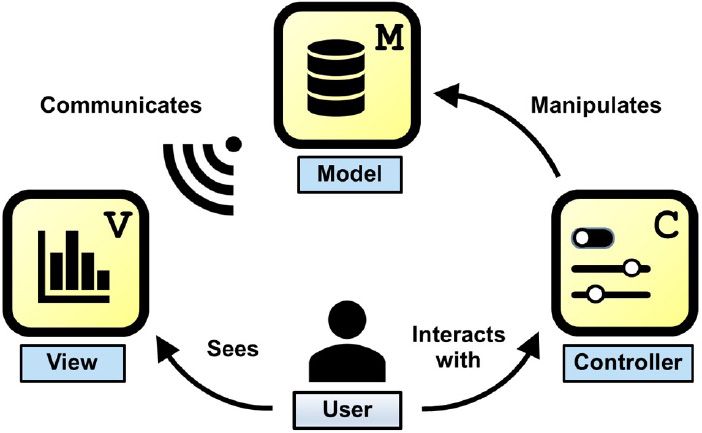Introducing the best futuristic programming language to learn in 2025
If you want to start programming language recently, we will introduce you three of the best.

MVC or Model-View-Controller architecture is a design pattern used to develop web applications. This model consists of
MVC or Model-View-Controller architecture is a design pattern used to develop web applications. This model consists of three main parts, each of which has its specific tasks.
First, the model that is responsible for data management and business logic.
The model acts as a data repository and applies any changes to the data.
This part of the program is independent from other parts and changes in the model are applied without affecting other parts.
Next, the view that is responsible for displaying data to the user.
The view has only the task of displaying data and does not implement any business logic.
View creates and displays web pages to the user based on the data it receives from the model.
Finally, the controller that acts as an interface between the model and the view.
The controller receives user requests, executes business logic, and then sends the necessary data to the view.
The controller plays an important role in managing the user flow and is responsible for the interaction between the model and the view.
In short, the MVC architecture makes coding simpler and more extensible by dividing the application's tasks into three different parts.
Using this model, changes in one part of the program do not have much impact on other parts, and the possibility of developing and maintaining the program is improved.
This pattern is one of the most popular design patterns for web application development and is used by many developers.
The model in MVC architecture is one of the three main elements of this architecture, which plays a very important role in dividing tasks and communicating between different parts of the program.
The model acts as a representative of data and business logic in the program and is responsible for storing and processing information.
One of the important features of the model is that it should be independent from other parts of the program and not have any direct relationship with the user interface or controller.
This makes the model independent and testable, and changes in the user interface or controller can be made without changing the model.
The model in MVC architecture usually includes classes and functions that are used to access data and perform logical operations on them.
This data can be from various sources such as database, files or external services.
One of the advantages of using the model in the MVC architecture is that it is possible to make changes in the data and business logic without changing other parts of the application.
In other words, if we need to add or change a feature in the data, we only need to apply these changes in the model, and other parts of the program automatically These changes are beneficial.
Finally, the model acts as a communication bridge between the data and other parts of the application and separates the business logic from the user interface and the controller.
This increases the reliability, testability and developability of the program and helps to improve the quality and performance of the program.
MVC architecture or Model-View-Controller is a design pattern that is used to divide the different tasks of an application into different parts.
In this template, there are three main parts: Model, View and Controller.
Each part has its own responsibilities and they interact to create an efficient and extensible program.

View's role is very important in MVC architecture.
View is responsible for displaying data to the user and provides the main user interaction with the application.
The view should display the information to the user appropriately and send the user's reactions to the controller to execute the business logic.
The view must be separated from the model to prevent the original data.
In this way, any changes in the data will only apply to the model and the view should display these changes automatically.
This increases the reliability and developability of the program.
The view must be separated from the controller to avoid interference between the display data and business logic.
The controller is responsible for the communication between the view and the model and announces any changes in the data to the view.
This communication is two-way and View can also send requests to the controller.
In general, the view in MVC architecture is responsible for displaying data to the user and receiving user reactions.
Given the importance of the view in this model, the appropriate design of the view and its separation from the model and the controller are of great importance.
This increases the reliability and developability of the program and helps to improve the performance and efficiency of the program.
MVC architecture or Model-View-Controller is a design pattern used to develop web applications.
This template is divided into three main parts: Model, View and Controller.
In this article, we examine the role of the controller in the MVC architecture.
Controller (Controller) in the MVC architecture is responsible for the connection between the model and the display.
This part of the program receives user requests and then performs related actions.
In other words, the controller performs its tasks as an intermediary between data and display.
One of the important features of the controller in MVC architecture is its separation from the model and display.
This isolation makes the changes in one of the sections, without affecting the other sections.
In other words, if there is a need for changes related to data or display, it is enough to change only the controller and not change other parts.
The controller is also responsible for validating data and performing logical operations on them.
For example, if a user fills out a registration form, the controller must ensure that the information entered is correct and then perform the necessary registration actions.
Finally, the controller in the MVC architecture acts as the control center of the application, and its main task is to implement the application logic and manage the user flow.
This part of the MVC pattern facilitates the improvement of reliability, maintainability and extensibility of the application and helps developers to create quality and reliable applications.< /p>
MVC architecture or Model-View-Controller is a design pattern used to develop web applications.
This template is divided into three main parts: Model, View and Controller.
One of the advantages of using MVC architecture is that this pattern helps to divide tasks and responsibilities in a project.
By dividing tasks in this way, changes in one section can be applied without affecting other sections.
For example, if we need changes in the user interface (View), we can apply these changes without needing to change the model or controller.</p style="direction: rtl;"> p>
Also, using MVC architecture increases the reliability and maintainability of the code.
By dividing tasks in this way, the code is more reusable and it becomes easier to test and modify it.
However, using MVC architecture also has its disadvantages.
One of its disadvantages is that the complexity of the code may increase.
By dividing tasks into three different parts, the code may become more complex and difficult to manage.
Also, for small and simple projects, using MVC architecture may be overkill.
In this case, using a simpler template can be the best option.
In general, the MVC architecture is a powerful design pattern that helps divide tasks and responsibilities and increases code maintainability and reliability.
However, it should be noted that its use should be considered according to the needs and characteristics of the project.
source » itroz Academy

What is AEO and why is the future of SEO dependent on it? In this article, get a complete and practical understanding of Answer Engine Optimization.

How AI Makes Decisions: A comprehensive and engaging look at machine learning models and how they work in the real world for the general public.

When it comes to creativity, are we talking about Sora or ChatGPT? So for a better understanding, let's compare.

A complete review to understand what the metaverse is? An important topic these days that we are examining from all angles.
Comments (0)